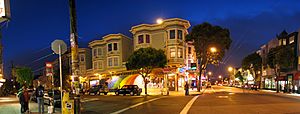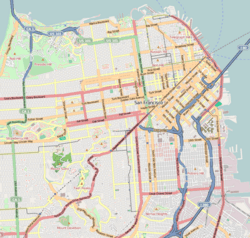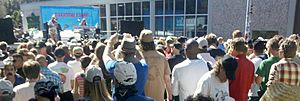Haight-Ashbury facts for kids
Quick facts for kids
Haight-Ashbury
|
|
|---|---|

Cole Street, left, and Haight Street, right
|
|
| Nicknames:
The Haight, Upper Haight, Hashbury, Psychedelphia
|
|
| Country | |
| State | |
| City and county | San Francisco |
| Area | |
| • Total | 0.309 sq mi (0.80 km2) |
| • Land | 0.309 sq mi (0.80 km2) |
| Population | |
| • Total | 10,601 |
| • Density | 34,253/sq mi (13,225/km2) |
| Time zone | UTC−8 (Pacific) |
| • Summer (DST) | UTC−7 (PDT) |
| ZIP code |
94117
|
| Area codes | 415/628 |
Haight-Ashbury is a district of San Francisco, California, named for the intersection of Haight and Ashbury streets. It is also called The Haight and The Upper Haight. The neighborhood is known as one of the main centers of the counterculture of the 1960s.
Contents
Location
The district generally encompasses the neighborhood surrounding Haight Street, bounded by Stanyan Street and Golden Gate Park on the west, Oak Street and the Golden Gate Park Panhandle on the north, Baker Street and Buena Vista Park to the east and Frederick Street and Ashbury Heights and Cole Valley neighborhoods to the south.
The street names commemorate two early San Francisco leaders: pioneer and exchange banker Henry Haight, and Munroe Ashbury, a member of the San Francisco Board of Supervisors from 1864 to 1870.
Both Haight and his nephew, as well as Ashbury, had a hand in the planning of the neighborhood and nearby Golden Gate Park at its inception. The name "Upper Haight" is also used by locals in contrast to the Haight-Fillmore or Lower Haight.
The Beats had congregated around San Francisco's North Beach neighborhood from the late 1950s. Many who could not find accommodation there turned to the quaint, relatively cheap and underpopulated Haight-Ashbury.
Haight-Ashbury would later become notable for its role as one of the main centers of the hippie movement. The Summer of Love (1967) and much of the counterculture of the 1960s have been synonymous with San Francisco and the Haight-Ashbury neighborhood ever since.
History
Farms, entertainment, and homes
Before the completion of the Haight Street Cable Railroad in 1883, what is now the Haight-Ashbury was a collection of isolated farms and acres of sand dunes. The Haight cable car line, completed in 1883, connected the east end of Golden Gate Park with the geographically central Market Street line and the rest of downtown San Francisco. As the primary gateway to Golden Gate Park, and with an amusement park known as the Chutes on Haight Street between Cole and Clayton Streets between 1895 and 1902 and the California League Baseball Grounds stadium opening in 1887, the area became a popular entertainment destination, especially on weekends. The cable car, land grading and building techniques of the 1890s and early 20th century later reinvented the Haight-Ashbury as a residential upper middle class homeowners' district. It was one of the few neighborhoods spared from the fires that followed the catastrophic San Francisco earthquake of 1906.
Depression and war
The Haight was hit hard by the Depression, as was much of the city. Residents with enough money to spare left the declining and crowded neighborhood for greener pastures within the growing city limits, or newer, smaller suburban homes in the Bay Area. During World War II, the Edwardian and Victorian houses were divided into apartments to house workers. Others were converted into boarding homes for profit. By the 1950s, the Haight was a neighborhood in decline. Many buildings were left vacant after the war. Deferred maintenance also took its toll, and the exodus of middle class residents to newer suburbs continued to leave many units for rent.
Postwar
In the 1950s, a freeway was proposed that would have run through the Panhandle, but due to a citizen freeway revolt, it was cancelled in a series of battles that lasted until 1966. The Haight Ashbury Neighborhood Council (HANC) was formed at the time of the 1959 revolt.
The Haight-Ashbury's elaborately detailed, 19th century, multi-story, wooden houses became a haven for hippies during the 1960s, due to the availability of cheap rooms and vacant properties for rent or sale in the district; property values had dropped in part because of the proposed freeway. The alternative culture that subsequently flourished there took root, and to some extent, has remained to this day.
Recent history
After 1968, the area went into decline due to a lack of policing, but was improved and renewed in the late 1970s.
In the 1980s, the Haight became an epicenter for the San Francisco comedy scene when a small coffee house near Haight Street, in Cole Valley, called The Other Café, 100 Carl Street at Cole Street (currently the restaurant Crepes on Cole) became a full-time comedy club that helped launch the careers of Robin Williams, Dana Carvey, and Whoopi Goldberg.
Attractions and characteristics
The Haight-Ashbury Street Fair is held on the second Sunday of June each year attracting thousands of people, during which Haight Street is closed between Stanyan and Masonic to vehicular traffic, with one sound stage at each end.
See also
 In Spanish: Haight-Ashbury para niños
In Spanish: Haight-Ashbury para niños



